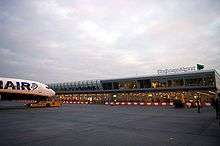Eindhoven
Eindhoven (/ˈaɪnthoʊvən/ EYENT-hoh-vən, Dutch: [ˈɛintɦoːvə(n)] (![]()
Eindhoven | |
|---|---|
City and municipality | |
  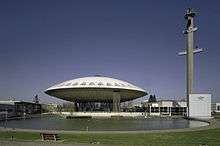 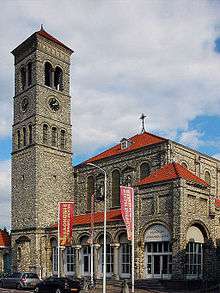  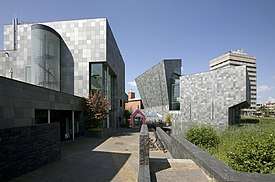 From top down, left to right: Skyline of Eindhoven, Light Tower at the city centre, Evoluon conference centre, St. Anthony Church, St. Catherine Church, Vesteda Tower, Van Abbe Museum, Philips Stadium of PSV Eindhoven, High Tech Campus Eindhoven | |
 Flag  Coat of arms | |
.svg.png) Location in North Brabant | |
| Coordinates: 51°26′N 5°29′E | |
| Country | |
| Province | |
| Government | |
| • Body | Municipal council |
| • Mayor | John Jorritsma (VVD) |
| Area | |
| • Municipality | 88.87 km2 (34.31 sq mi) |
| • Land | 87.72 km2 (33.87 sq mi) |
| • Water | 1.15 km2 (0.44 sq mi) |
| Elevation | 17 m (56 ft) |
| Population | |
| • Municipality | 231,642 |
| • Density | 2,641/km2 (6,840/sq mi) |
| • Urban | 337,487 |
| • Metro | 419,045 |
| • Metro region | 755,313 |
| • CMSA | 1,944,588 |
| Demonym(s) | Eindhovenaar |
| Time zone | UTC+1 (CET) |
| • Summer (DST) | UTC+2 (CEST) |
| Postcodes | 5600–5658 |
| Area code | 040 |
| Website | www |
Neighbouring cities and towns include Son en Breugel, Nuenen, Geldrop-Mierlo, Helmond, Heeze-Leende, Waalre, Veldhoven, Eersel, Oirschot and Best. The agglomeration has a population of 337,487. The metropolitan area consists of 419,045 inhabitants. The city region has a population of 753,426. The Brabantse Stedenrij combined metropolitan area has about two million inhabitants.
Name
The name may derive from the contraction of the regional words eind (meaning "last" or "end") and hove (or hoeve, a section of some 14 hectares of land). Toponymically, eind occurs commonly as a prefix and postfix in local place- and streetnames. A "hove" comprised a parcel of land which a local lord might lease to private persons (such as farmers). Given that a string of such parcels existed around Woensel, the name Eindhoven may have originated with the meaning "last hoves on the land of Woensel". Another explanation is that "Eind" has deriven from "Gender", a river that goes through the city.
History
13th–15th centuries
The written history of Eindhoven started in 1232, when Duke Hendrik I of Brabant granted city rights to Eindhoven, then a small town right on the confluence of the Dommel and Gender streams. At the time of granting of its charter, Eindhoven had approximately 170 houses enclosed by a rampart. Just outside the city walls stood a small castle. The city was also granted the right to organize a weekly market and the farmers in nearby villages were obliged to come to Eindhoven to sell their produce. Another factor in its establishment was its location on the trade route from Holland to Liège.
Around 1388, the city's fortifications were strengthened further. And between 1413 and 1420, a new castle was built within the city walls. In 1486, Eindhoven was plundered and burned by troops from Guelders.
16th–18th centuries
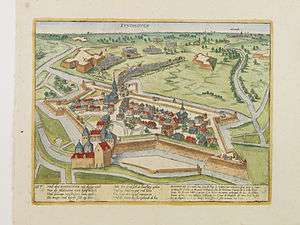
The reconstruction of Eindhoven was finished in 1502, with a stronger rampart and a new castle. However, in 1543 it fell again, its defense works having been neglected due to poverty.
A big fire in 1554 destroyed 75% of the houses but by 1560 these had been rebuilt with the help of William I of Orange. During the Dutch Revolt, Eindhoven changed hands between the Dutch and the Spanish several times during which it was burned down by renegade Spanish soldiers, until finally in 1583 it was captured once more by Spanish troops and its city walls were demolished.
Eindhoven did not become part of the Netherlands until 1629. During the French occupation, Eindhoven suffered again with many of its houses destroyed by the invading forces. Eindhoven remained a minor city after that until the start of the industrial revolution.
19th century
The industrial revolution of the 19th century provided a major growth impulse. Canals, roads and railroads were constructed. Eindhoven was connected to the major Zuid-Willemsvaart canal through the Eindhovens Kanaal branch in 1843 and was connected by rail to Tilburg, 's-Hertogenbosch, Venlo and Belgium between 1866 and 1870. Industrial activities initially centred around tobacco and textiles and boomed with the rise of lighting and electronics giant Philips, which was founded as a light bulb manufacturing company in Eindhoven in 1891.
Industrialisation brought population growth to Eindhoven. On the establishment of the Kingdom of the Netherlands in 1815, Eindhoven had 2,310 inhabitants.
20th century
By 1920, the population was 47,946; by 1925 it was 63,870 and in 1935 that had ballooned to 103,030.[11] The explosive growth of industry in the region and the subsequent housing needs of workers called for radical changes in administration, as the City of Eindhoven was still confined to its medieval moat city limits. In 1920, the five neighbouring municipalities of Woensel (to the north), Tongelre (northeast and east), Stratum (southeast), Gestel en Blaarthem (southwest) and Strijp (west), which already bore the brunt of the housing needs and related problems, were incorporated into the new Groot-Eindhoven ("Greater Eindhoven") municipality. The prefix "Groot-" was later dropped.

After the incorporation of 1920, the five former municipalities became districts of the Municipality of Eindhoven, with Eindhoven-Centrum (the City proper) forming the sixth. Since then, an additional seventh district has been formed by dividing the largest district, that of Woensel, into Woensel-Zuid and Woensel-Noord.
The early 20th century saw additions in technical industry with the advent of car and truck manufacturing company Van Doorne's Automobiel Fabriek (DAF) and the subsequent shift towards electronics and engineering, with the traditional tobacco and textile industries waning and finally disappearing in the 1970s.
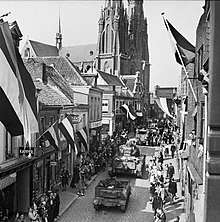
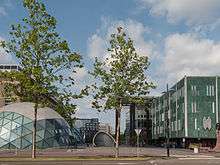
A first air raid in World War II was flown by the RAF on 6 December 1942 targeting the Philips factory downtown. 148 civilians died, even though the attack was carried out on a Sunday by low-flying Mosquito bombers.[12][13] Large-scale air raids, including the bombing by the Luftwaffe on 18 September 1944 during Operation Market Garden, destroyed large parts of the city. The reconstruction that followed left very little historical remains and the postwar reconstruction period saw drastic renovation plans in highrise style, some of which were implemented. At the time, there was little regard for historical heritage. During the 1960s, a new city hall was built and its neogothic predecessor (1867) demolished to make way for a planned arterial road that never materialised.
The 1970s, 1980s, and 1990s saw large-scale housing developments in the districts of Woensel-Zuid and Woensel-Noord, making Eindhoven the fifth-largest city in the Netherlands. At the start of the 21st century, a whole new housing development called Meerhoven was constructed at the site of the old airport of Welschap, west of Eindhoven. The airport itself, now called Eindhoven Airport, had moved earlier to a new location, paving the way for much needed new houses. Meerhoven is part of the Strijp district and partially lies on lands annexed from the municipality of Veldhoven.
Geography
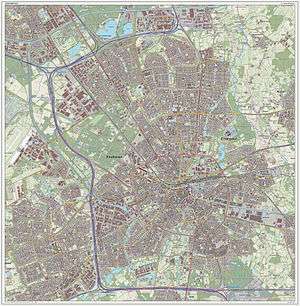
The villages and city that make up modern Eindhoven were originally built on sandy elevations between the Dommel, Gender and Tongelreep streams. Beginning in the 19th century, the basins of the streams themselves have also been used as housing grounds, resulting in occasional floodings in the city centre. Partly to reduce flooding, the bed of the Gender stream, which flowed directly through the city centre, was dammed off and filled up after the War, and the course of the Dommel was regulated. New ecological and socio-historical insights have led to parts of the Dommel's course being restored to their original states, and plans to have the Gender flow through the centre once again.[14]
The large-scale housing developments of the 20th century saw residential areas being built on former agricultural lands and woods, former heaths that had been turned into cultivable lands in the 19th century.
The city is currently divided into seven districts:
|
Climate
Eindhoven has an oceanic climate with slightly warmer summers and colder winters than the coastal parts of the Netherlands. Its all-time record is 40.3 °C (104.5 °F) set on 25 July 2019 and −21.7 °C (−7.1 °F) set on 13 January 1968, while winter lows have dipped below −15 °C (5 °F) during extreme cold snaps. Although frosts are frequent in winter, there is no lasting snow cover in a normal winter due to the mild daytime temperatures.
| Climate data for Eindhoven, Netherlands for 1981– (Source: KNMI) | |||||||||||||
|---|---|---|---|---|---|---|---|---|---|---|---|---|---|
| Month | Jan | Feb | Mar | Apr | May | Jun | Jul | Aug | Sep | Oct | Nov | Dec | Year |
| Record high °C (°F) | 16.3 (61.3) |
19.9 (67.8) |
24.6 (76.3) |
29.1 (84.4) |
33.4 (92.1) |
35.1 (95.2) |
40.3 (104.5) |
36.6 (97.9) |
33.1 (91.6) |
27.0 (80.6) |
20.6 (69.1) |
16.4 (61.5) |
40.3 (104.5) |
| Average high °C (°F) | 5.7 (42.3) |
6.6 (43.9) |
10.5 (50.9) |
14.5 (58.1) |
18.6 (65.5) |
21.1 (70.0) |
23.4 (74.1) |
23.1 (73.6) |
19.5 (67.1) |
14.9 (58.8) |
9.6 (49.3) |
6.1 (43.0) |
14.5 (58.1) |
| Daily mean °C (°F) | 3.0 (37.4) |
3.3 (37.9) |
6.3 (43.3) |
9.5 (49.1) |
13.5 (56.3) |
16.0 (60.8) |
18.2 (64.8) |
17.7 (63.9) |
14.6 (58.3) |
10.8 (51.4) |
6.6 (43.9) |
3.6 (38.5) |
10.3 (50.5) |
| Average low °C (°F) | 0.0 (32.0) |
−0.1 (31.8) |
2.2 (36.0) |
4.1 (39.4) |
7.8 (46.0) |
10.5 (50.9) |
12.8 (55.0) |
12.2 (54.0) |
9.8 (49.6) |
6.7 (44.1) |
3.3 (37.9) |
0.8 (33.4) |
5.8 (42.4) |
| Record low °C (°F) | −21.7 (−7.1) |
−21.6 (−6.9) |
−14.7 (5.5) |
−5.9 (21.4) |
−2.6 (27.3) |
0.3 (32.5) |
2.9 (37.2) |
3.6 (38.5) |
−0.4 (31.3) |
−6.4 (20.5) |
−9.6 (14.7) |
−17.4 (0.7) |
−21.7 (−7.1) |
| Average precipitation mm (inches) | 63.6 (2.50) |
56.9 (2.24) |
58.2 (2.29) |
44.5 (1.75) |
54.6 (2.15) |
62.5 (2.46) |
77.2 (3.04) |
71.2 (2.80) |
62.6 (2.46) |
62.6 (2.46) |
78.8 (3.10) |
70.4 (2.77) |
750.0 (29.53) |
| Average precipitation days (≥ 0.1 mm) | 16 | 14 | 16 | 13 | 13 | 14 | 14 | 13 | 14 | 15 | 17 | 17 | 176 |
| Average snowy days (≥ 0.1 cm) | 6 | 6 | 4 | 1 | 0 | — | — | — | — | 0 | 2 | 5 | 24 |
| Average relative humidity (%) | 87 | 84 | 80 | 74 | 73 | 75 | 75 | 77 | 83 | 85 | 89 | 90 | 81 |
| Mean monthly sunshine hours | 61.5 | 84.0 | 120.8 | 170.2 | 202.5 | 191.5 | 204.8 | 188.8 | 141.7 | 115.9 | 65.1 | 48.1 | 1,603.6 |
Demographics
Population
As of 2019, the population of Eindhoven consisted of 355,889 persons (according to Worldpopulationreview).[15] Of these, 29.5% or some 63,873 people are of foreign descent.[16] People are classified as being of foreign descent when they were born outside of the Netherlands, or when at least one of their parents was born outside of the Netherlands.
Large minority groups include:[17]
- Non-Western, at least in part: 38,303 (17.5%)
- Turks (10,337) (4.7%)
- Moroccans (5,907) (2.6%)
- Surinamese (3,771) (1.7%)
- Antilleans/Arubans (2,704) (1.2%)
- Indian (2,088) (0.7%)
- Chinese (3,452)
- Others (14,420) (6.6%)
- Western, at least in part: 28,578 (11.1%)
- Indos (6,248) (2.9%)
- Germans (5,115) (2.4%)
- Belgians (2,651) (1.2%)
- British (1,410) (0.6%)
- Spaniards (1,226) (0.5%)
- Eastern European origin, at least in part: 4,341 (2%)
- Polish (2,956) (1.2%)
- Former Yugoslavia (1,386)
- Former Soviet Union (1,534)
The municipal agglomeration of Eindhoven (an administrative construct which includes only some of the surrounding towns and villages) has 327,245 inhabitants as of 1 January 2010.
The spoken language is a combination of Kempenlands (a Dutch dialect spoken in a large area east and south east of the city, including Arendonk and Lommel in Belgium) and North Meierijs (between the south of Den Bosch and into Eindhoven). Both dialects belong to the East Brabantian dialect group), which is very similar to colloquial Dutch).[18]
Districts
Of all Eindhoven districts, the historical centre is by far the smallest in size and population, numbering only 5,419 in 2006. Woensel-Noord is the largest, having been the city's main area of expansion for several decades.
Population figures for all districts, as of 1 January 2008, ranked by size:[19]
Religion
Eindhoven is located in the southeast of the province of North Brabant. This area is historically Roman Catholic and the population of Eindhoven was similarly mostly Catholic for a very long time until the late 1970s. However, the internationalizing influence of the university, Philips and other companies have created a more mixed population over the last few decades.
The spiritual needs of the Eindhoven population are tended to by a steadily shrinking number of churches,[21] two mosques and one synagogue.
Crime
In research by the Dutch newspaper Algemeen Dagblad based on the police's statistical data on crime rates, Eindhoven was found to have the highest crime rate in the Netherlands for 2006, 2007, 2009, and 2010. In 2011, Eindhoven has slipped down the list to number six.[22]
In 2009, in the Eindhoven agglomeration, the following numbers of crimes were recorded:[23]
| Category | Number |
|---|---|
| Total | 61,539 |
| Monetary (including burglary, theft) | 37,266 |
| Destruction and public disorder | 9,861 |
| Violent crime | 5,568 |
| Other crimes (criminal code) | 562 |
| Traffic crimes | 6,665 |
| Drug related | 1,094 |
| (Fire)arms related | 343 |
| Environmental | 19 |
| Other crimes (other laws) | 161 |
Languages
- Standard Dutch[24]
- Eindhoven does not have its own, uniform dialect. Varieties of the Brabantian dialect used to be spoken in the former villages of Gestel, Woensel and Stratum, but are now almost extinct. The closest city to Eindhoven in which Brabantian is spoken is Helmond.[24]
Economy
Eindhoven has grown from a little town in 1232 to one of the biggest cities in the Netherlands with around 230,000 inhabitants in 2020. Much of its growth is due to Philips, DAF Trucks and Brabantia.
After the resurrection of the Netherlands in 1815 and the end of the Belgian Revolution, Eindhoven was a small village of some 1250 people in an economically backward and mostly agricultural area. Cheap land, cheap labor and the existence of pre-industrial homesourcing (huisnijverheid in Dutch) made Eindhoven an attractive area for the developing industries which were being stimulated by the government of King William I. During the 19th century, Eindhoven grew into an industrial town with factories for textile weaving, cigar manufacturing, match making and hat making. Most of these industries disappeared again after World War II, though.
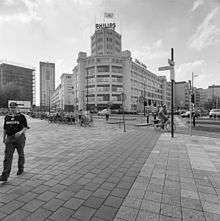
In 1891, brothers Gerard and Anton Philips founded the small light bulb factory that would grow into one of the largest electronics firms in the world. Philips' presence is probably the largest single contributing factor to the major growth of Eindhoven in the 20th century. It attracted and spun off many hi-tech companies, making Eindhoven a major technology and industrial hub. In 2005, a full third of the total amount of money spent on research in the Netherlands was spent in or around Eindhoven. A quarter of the jobs in the region are in technology and ICT, with companies such as FEI Company (once Philips Electron Optics), NXP Semiconductors (formerly Philips Semiconductors), ASML, ALTEN, Simac, Neways Electronics and the aforementioned Philips and DAF.
Eindhoven has long been a centre of cooperation between research institutes and industry. This tradition started with Philips (the NatLab was a physical expression of this) and has since expanded to large cooperative networks. The Eindhoven University of Technology hosts an incubator for technology startups and the NatLab has developed into the High Tech Campus Eindhoven. Also, TNO has opened a branch on the university campus. This tradition has also fostered inter-industry cooperation in the region; one example of this is the announcement in September 2010 of a new research lab for high-grade packaging materials, a cooperation of IPS Packaging and Thales Cryognetics.[25]
This cooperative tradition has also developed into a different direction than the traditional technology research done at the university. Starting in 2002, the university, the Catharina hospital, Philips Medical and the University of Maastricht joined forces and started joint research into biomedical science, technology and engineering. Within Eindhoven, this research has been concentrated in a new university faculty (BioMedical Technology or BMT). This development has also made Eindhoven a biomedical technology hub within the country and its (European) region.
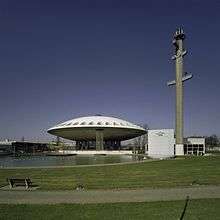
Prime examples of industrial heritage in Eindhoven are the renovated Witte Dame ("White Lady") complex, a former Philips lamp factory; and the Admirant building (informally known as Bruine Heer or "Brown Gentleman" in reference to the Witte Dame across the street), the former Philips main offices. The Witte Dame currently houses the municipal library, the Design Academy and a selection of shops. The Admirant has been renovated into an office building for small companies. Across the street from the Witte Dame and next to the Admirant is Philips' first light bulb factory (nicknamed Roze Baby, or "Pink Baby", in reference to its pink colour and much smaller size when compared to the "White Lady" and "Brown Gentleman"). The small building now houses the "Centrum Kunstlicht in de Kunst" (centre artificial light in art)[26] and the "Philips Incandescent Lamp Factory of 1891" museum.[27]
Knowledge economy initiatives
Due to its high-tech environment, Eindhoven is part of several initiatives to develop, foster and increase a knowledge economy. Chief among these are:
- Brainport Top Technology Region:[28] A cooperative initiave of local government, industry and the Eindhoven University of Technology to develop the local knowledge economy of the Eindhoven region.
- Brainport Development:[29] An extension of the Top Technology Region, Brainport Development serves as the Eindhoven's regional innovation agency to maintain its position as top innovation hub in the world.[30]
- SRE:[31] The Samenwerkingsverband Regio Eindhoven is a cooperative agreement among the municipalities in the Eindhoven metropolitan area. Although SRE is far more than just an economic agreement, it includes economic cooperation.
- The Eindhoven-Leuven-Aachen triangle:[32] An extensive cooperation agreement between the universities and surrounding regions of Eindhoven, Leuven (Belgium) and Aachen (Germany).
- Within the Eindhoven region (particularly around Helmond), several parties are working together to set up an automotive testing facility of European scale, for testing and European certification of vehicles. This cooperation involves the Eindhoven University of Technology, TNO Automotive and the different automotive companies in and around Helmond.
As a result of these efforts, the Intelligent Community Forum named the Eindhoven metro region one of the top-21 intelligent communities in 2008 and one of the top-7 intelligent communities in 2009 and 2010.[33][34] Finally, in 2011, the ICF named Eindhoven the Intelligent Community of the Year.[35]
EIT Co-location
Eindhoven is one of the co-location centres of the European Institute of Innovation and Technology (EIT).[36] It hosts two Knowledge and Innovation Communities (KICs): Innoenergy (Sustainable Energy) and EIT ICT Labs (Information and Communication Technology). The co-locations are on the High Tech Campus Eindhoven.
Education
Eindhoven, being a city with a 200,000+ population, is served by a large number of schools both at primary and secondary education levels. In addition, Eindhoven is a higher-education hub within the southern Netherlands, with several institutes of higher education that serve students from the extended region of North Brabant, Zeeland, Limburg and parts of the surrounding provinces.
Primary education
Primary education is provided to the children aged 4 to 12 in Eindhoven through a large number of primary schools:
| Area | Gestel | Stratum | Strijp | Tongelre | Woensel |
|---|---|---|---|---|---|
| Schools |
|
|
|
|
|
- Special needs primary education:
- SALTO school Jan Nieuwenhuizen
- SKPO school De Reis van Brandaan
- SKPO school Petraschool
- SALTO school De Vijfkamp
Secondary education
Secondary education is provided to the children aged 12 to 18 in Eindhoven through several highschools:
| Area | Gestel | Stratum | Strijp | Tongelre | Woensel |
|---|---|---|---|---|---|
| Schools |
|
|
|
|
|
Special needs secondary education:
- Sondervickcollege, Locatie de Stolberg
- De Korenaer
- Mgr. Bekkers
- De Beemden
- Mytylschool
- Antoon Schellens College
- Praktijkschool Eindhoven
- VSO Ekkersbeek
- Instituut 'St. Marie'
Higher and adult education
Eindhoven hosts four different public institutions for higher and adult education, as well as a number of private institutions offering courses and trainings. The public institutions hosted in Eindhoven are:
- The Design Academy.
- The Eindhoven University of Technology.
- The Fontys University of Applied Sciences (Eindhoven branch).
- Sint Lucas Eindhoven
- Summa College
The Open University also has a study center in Eindhoven.
Among the private institutions is the Centrum voor Kunsten Eindhoven, which offers art-related courses to adults (including a DJ-education).
Politics
Municipal council
The municipal council is the legislative council at the municipal level in Eindhoven; its existence is mandated by the Constitution of the Netherlands. The Eindhoven city council consists of 45 elected representatives from the Eindhoven municipality. These are elected during municipal elections from candidates running in Eindhoven. Eindhoven politics consists of local branches of the national political parties and purely local parties with strictly local interests. The city council reflects this mix in its makeup.
The last three municipal elections were held on 7 March 2006, 3 March 2010 and 19 March 2014. The division of the 45 seats in the Eindhoven city council after these elections is shown below:[37]
| Party | Percentage in 2006 | Seats in 2006 | Percentage in 2010 | Seats in 2010 | Percentage in 2014 | Seats in 2014 | Percentage in 2018 | Seats in 2018 |
|---|---|---|---|---|---|---|---|---|
| VVD | 11.78% | 6 | 15.65% | 8 | 13.5% | 6 | 14.7% | 7 |
| GreenLeft | 7.07% | 3 | 8.88% | 4 | 7.6% | 4 | 14.4% | 7 |
| PvdA | 26.99% | 14 | 20.56% | 10 | 15.9% | 8 | 12.3% | 6 |
| D66 | 3.33% | 1 | 12.19% | 6 | 14.7% | 7 | 11.7% | 6 |
| CDA | 14.60% | 7 | 11.50% | 6 | 8.0% | 4 | 11.4% | 5 |
| SP | 12.87% | 6 | 8.70% | 4 | 14.6% | 7 | 7.9% | 4 |
| Senior Appeal Eindhoven | 4.88% | 2 | 6.23% | 3 | 9.7% | 5 | 5.5% | 2 |
| Pim Fortuyn List | 2.27% | 1 | 4.57% | 2 | 3.7% | 1 | 3.9% | 2 |
| 50Plus | - | - | - | - | - | - | 3.9% | 2 |
| DENK | - | - | - | - | - | - | 3.4% | 1 |
| Livable Eindhoven | 8.88% | 4 | 3.22% | 1 | 4.0% | 2 | 2.8% | 1 |
| ChristianUnion | 2.22% | 1 | 1.81% | 0 | 2.0% | 1 | 2.3% | 1 |
| Wide Left Movement | - | - | - | - | - | - | 1.9% | 0 |
| Forum040 | - | - | - | - | - | - | 1.2% | 0 |
| Stratum's Interest | - | - | - | - | - | - | 1.2% | 0 |
| Future Party (PvdT) | 1.05% | 0 | 0.8% | 0 | 0.6% | 0 | 0.9% | 0 |
| Blanco lijst, 1e kand. M. Leenders | - | - | - | - | 1.5% | 0 | - | - |
| Disappointed Citizens | - | - | - | - | 1.5% | 0 | - | - |
| Together Eindhoven | - | - | - | - | 1.1% | 0 | - | - |
| Unity Party | - | - | - | - | 0.7% | 0 | - | - |
| OPA Eindhoven | - | - | - | - | 0.7% | 0 | - | - |
| The Greens | - | - | - | - | 0.1% | 0 | - | - |
| Trots op Nederland/Lijst Rita Verdonk | - | - | 2.84% | 1 | - | - | - | - |
| City Party | 2.44% | 1 | 1.40% | 0 | - | - | - | - |
| Eindhoven Now | - | - | 1.16% | 0 | - | - | - | - |
| Human and Spirit Party | - | - | 0.49% | 0 | - | - | - | - |
| Students List Eindhoven | 1.69% | 0 | - | - | - | - | - | - |
| New Right | 0.98% | 0 | - | - | - | - | - | - |
| Liberal Eindhoven | 0.90% | 0 | - | - | - | - | - | - |
Election results (percentages) 2010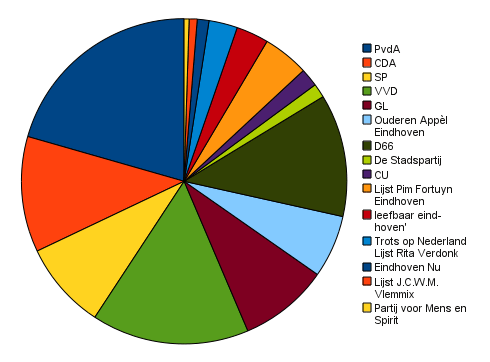 Election results (percentages) 2010 |
||||||||
Municipal executive-
Aldermen
The executive council in Dutch municipalities is called the College of the Mayor and Aldermen (Dutch: College van Burgemeester en Wethouders or College van B&W for short). The mayor is appointed by the monarch, but the council of aldermen is composed as a result of the formation of a local coalition government. This coalition is formed in such a way as to be able to rely on a majority of the votes in the city council.
In May 2014, a coalition was formed between PvdA, D66, SP and GroenLinks. Together they have 26 seats in the city council. The council of aldermen consists of the following people:[38]
- Mary-Ann Schreurs (D66): innovation and design, sustainability and culture
- Lenie Scholten (GreenLeft): healthcare and WIJeindhoven
- Staf Depla (PvdA): economy, work and income and vocational education
- Bianca van Kaathoven (SP): Active city, diversity and permits
- Marco van Dorst (D66): Spatial planning and treasury
- Yasin Torunoglu (PvdA): Living, boroughs, space and citizen participation
- Jannie Visscher (SP): Youth, education, traffic and transport
Mayor
The mayors of the Netherlands are not elected but appointed by the crown. Nevertheless, there has been a movement over the last few years to give the municipalities more say in who will be their mayor, which has resulted in consultative referenda being held in the larger cities to "suggest" a candidate for the post. This was also tried in Eindhoven and as a result the previous mayor was Rob van Gijzel (PvdA).
On 23 January 2008, a referendum to elect a mayor was held in Eindhoven. This referendum, the second of its kind in the Netherlands, was attended by 24.6% of the inhabitants. This was less than the required 30% needed to make a referendum binding. Nevertheless, the city council would choose the winner of the referendum as the preferred candidate. The main reason for the low attendance was that the candidates, Leen Verbeek and Rob van Gijzel, were from the same party. Rob van Gijzel won the referendum with 61.8% of the votes and was appointed the city's new mayor.
The mayor is the chairman of the Council of B&W. He also has responsibility for a number of specific posts (like the aldermen). In the previous council, mayor Van Gijzel held responsibility for the following posts:[38]
- Communication
If unavailable, the mayor is temporarily replaced by one of the aldermen.
Culture and recreation
Culturally and recreationally, Eindhoven was formed by two forces:
- Being a university city, Eindhoven has a large student population. The students from the Eindhoven University of Technology and a number of undergraduate schools give Eindhoven a young population, whose recreational needs are catered to by several different festivals, clubs and such.
- For a long time Eindhoven was the main location of Philips. The Philips company undertook a lot of effort in the "cultural formation" of its workforce and has given the city both cultural institutions (such as the former POC and the Muziekcentrum Frits Philips) and sporting institutions (notably PSV).
Eindhoven is also known as the City of Light, due to Philips originating from there and because of several projects involving lighting up buildings of the city. During Carnival, Eindhoven is rechristened Lampegat (Hamlet of Lamps, although for the ironic purposes of carnival the translation Hole in the ground with lamps is closer to the mark); this refers again to the important role of Philips in the Eindhoven community.
Cultural institutions
There are several cultural institutions in and around the city.
Museums
- There are two museums dedicated to the major topics of the city's industrial heritage: the DAF Museum has a collection of DAF cars and the Philips Gloeilampenfabriekje anno 1891 (across the street from the Kempenland) documents the early lightbulb industry.
- The former district court house now houses the Designhuis, a public podium and interaction area for modern design and innovation.
- The Eindhoven Museum is an archaeological open-air museum which focuses on the region's Iron Age and Middle Ages. It merged in 2011 with Museum Kempenland which was a regional museum, which documents the history of the Kempenland region in objects, documents, paint and educational activities. Museum Kempenland's old location, the Steentjeskerk, is closed.
- The Inkijkmuseum (the Look-In museum; housed in an old linen factory in the Dommelstraat) is a small but special museum: it offers ever-changing exhibits, which are to be viewed through the building's windows.
- The Van Abbemuseum has a collection of modern and contemporary art, including works by Picasso, Kandinsky, Mondriaan and Chagall.
- De Ontdekfabriek (Discovery Factory) children's museum at Strijp-S
Eindhoven was home to the Evoluon science museum, sponsored by Philips. The Evoluon building has evolved into a conference centre.
Open-air art
The Eindhoven public space contains many forms of artistic expression (a book published by the Eindhoven tourist board records 550 as of 2001 and more have been added since), with high "concentrations" of them in the parks. The Stadswandelpark for instance, contains over 30 works of modern art. There are also several other works of art on permanent display throughout the city, such as Flying Pins (by Claes Oldenburg and Coosje van Bruggen, who considered the location on the southern stretch of the John F. Kennedylaan to be like a bowling alley) and Swing (a construct on the Karel de Grotelaan, which morphs into different geometric shapes as you move around it). There are also a number of statues of famous city inhabitants, such as Jan van Hooff (by Auke Hettema, 1992) and Frits Philips (by Kees Verkade) on the Market Square. There is a statue of Anton Philips in front of the central railway station.
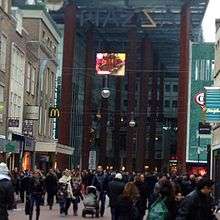
Eindhoven is also, to some degree, open to forms of impromptu and alternative art. For example, the Berenkuil is a freezone for graffiti artists in the city.
Light art
Strijp-S is a place for experimentiation with LED lighting, which keeps the historic connection with Philips' past.[39] Some light art includes the project Fakkel by Har Hollands. In the underground passage to NatLab artist Daan Roosegaarde installed his project Crystal.
Strijp-S is a regular location for the light festival GLOW.[40][41]
Music and theatre
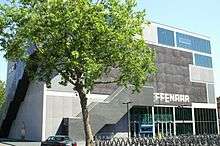
The Effenaar is a popular music venue and cultural center in Eindhoven, and is located at the Dommelstraat.[42]
In 1992, the Muziekcentrum Frits Philips was opened as a stage for classical and popular music in Eindhoven, reviewed by critics as a concert hall with acoustics that rival the best halls in Europe. Before that, Philips sponsored the POC.
Parktheater Eindhoven is Eindhoven's stage for opera, cabaret, ballet etc. Opened in 1964, it has received over 250,000 visitors every year. With its 1,000 m2 it has one of the largest stages in the Netherlands. With a major renovation ending in 2007, the new Parktheater will receive an estimated 300,000 visitors a year.
Eindhoven's Plaza Futura is now a cinema featuring cultural movies, lectures and special cultural events.
Especially for students, Studium Generale Eindhoven organizes "socially, culturally and intellectually formative events".[43] From within the student body, two Tunas provide entertainment from time to time at university and city events: Tuna Ciudad de Luz (Tuna of the City of Light) and the ladies tuna La Tuniña.[44][45]
The general music and theatre scene in Eindhoven (in the broadest sense) is supported by a foundation called PopEi.[46] The purpose of this foundation is to support artistic groups with facilities, especially rehearsal stages and areas (housed in the old Philips location of Strijp-S) but also storage facilities. PopEi also provides a working environment for groups (through cafeteria facilities in Strijp-S, so groups can have real working days) and provides some logistical support for organizing events.
Recreation
Eindhoven has a lively recreational scene. For going out, there are numerous bars on the Market square, Stratumseind (Stratum's End) which is the largest pub-street in the Netherlands, Dommelstraat, Wilhelmina square and throughout the rest of the city. In addition to the more culturally oriented Plaza Futura, there are three cinemas in the centre of town ("Servicebioscoop Zien", "Vue" and Pathé Eindhoven, which offers THX sound, IMAX screens and 3D movie viewing).
Eindhoven also hosts a large number of cultural and entertainment-oriented festivals. The biggest festivals in Eindhoven are:
- ABlive, popfestival (September)[47]
- Carnaval, (February)
- Koningsdag, national day (27 April)
- Muziek op de Dommel, classical music festival (June)[48]
- EDIT, festival (June)
- Fiesta del Sol, street- and music acts (June)
- UCI ProTour – Eindhoven Team Time Trial, international cycling tour (June)
- Virus Festival, alternative music festival (last edition in 2007, inactive at the moment)[49]
- Dynamo Metal Fest (July)
- Park Hilaria, fun fair (August)
- Folkwoods, folk festival (August)
- Reggae Sundance, reggae festival (August)
- Lichtjesroute, 15-mile-tour of light ornaments, commemorating the liberation of Eindhoven (from 18 September)
- Eindhoven Marathon, (October)
- Dutch Design Week, international school festival (October)
- GLOW Festival Eindhoven
- TROMP international music competition & Festival, international classical music competition & festival (15–23 November 2008: String Quartet, Nov 2010: Percussion)
- STRP Festival, art & technology festival (23–25 November 2007)[50]
Parks
Eindhoven contains several parks and a lot of open, green space. Of the five largest cities in the Netherlands, it has the highest percentage of green area (encompassing about ⅓ of all public space). It is also the greenest of the five largest cities in North Brabant. The green area per house is about 100 square metres (1,100 square feet).[51]
Some of the major parks in Eindhoven are the Stadswandelpark, Genneper Parken, the Philips van Lenneppark, Philips de Jongh Wandelpark and the Henri Dunantpark. There is also a green area surrounding the Karpendonkse Plas (a water area). The combination of park area, water and general atmosphere got the Ooievaarsnest neighborhood elected the "Best large-city neighborhood of the Netherlands" by the NRC Handelsblad in 1997.[52]
Sport
- The premier sporting club of the city is PSV Eindhoven, the professional football club playing in the Eredivisie. Their home base is the Philips Stadion. PSV won the 1988 European Cup as well as 24 Dutch championships.
- FC Eindhoven is another football club based in Eindhoven, currently playing in the Eerste Divisie.
- HC Oranje-Rood is the biggest field hockey club in Eindhoven and in fact one of the biggest clubs in the Netherlands. It is a combination of former clubs Oranje Zwart and EMHC. Oranje Zwart's men's team was the reigning Dutch champion for the past 3 years (14/15/16).[53] They also won the EHL in 2015.[54]
- Eindhoven Kemphanen is the major ice hockey club in the city. They play in Ijssportcentrum Eindhoven and compete in the North Sea Cup.
- Eindhoven High Techs are the minor league affiliate of the Eindhoven Kemphanen and play in the Eerste Divisie.
- Swimming pool complex De Tongelreep houses various pools for recreation, training and sports research supported by the Eindhoven University of Technology and several top sporting institutions. Its "Pieter van den Hoogenband Swimming Stadium" hosted the 2008 European Championships Swimming, Diving and Synchronised Swimming, the 2010 IPC Swimming World Championships, the 2010 European Short Course Swimming Championships, the 2012 European Championships Waterpolo, Diving and Synchronised Swimming, the 2013 FINA Swimming World Cup, the 2014 IPC European Swimming Championships, the 2017 FINA Swimming World Cup and the 2018 FINA Swimming World Cup.
- Eindhoven houses Europe's largest indoor skateboard park Area 51 (skatepark) and is home of a lively skateboard culture.
- Eindhoven has two boxing clubs, The Golden Gloves and Muscle Fit.
- Eindhoven hosted the 1999 World Table Tennis Championships.
- Eindhoven Shamrocks Gaelic Football Club are an amateur sports team. The club was founded in 2013 and is based at Oude Bosschebaan 32, 5624 AA in Eindhoven.[55] The club is affiliated to the European County Board of the Gaelic Athletic Association. The Shamrocks have won the Benelux Shield Competition in 2017.[56]
- Eindhoven has a baseball club called PSV, which plays at the stadium which co-hosted the 2005 IBAF Baseball World Cup.
- Eindhoven has an Australian Rules Football team, the Eindhoven Eagles, due to play in the inaugural Dutch Australian Football Association competition in 2010.
- Eindhoven has an American Football team, Eindhoven Raptors, which plays at the 1st division in the Dutch American Football League
- Strijp-S is a magnet for urban sports like skateboarding, BMX and bouldering as well as bootcamp classes.
- Eindhoven has two Rugby union Clubs ESRC The Elephants a student rugby club associated with the Eindhoven University of Technology and Rugbyclub Eindhoven formerly known as RCE/PSV
Adult-orientated entertainment
The centre of town features two casinos (one branch of Holland Casino and the independent Casino4Events). At the A67 a Jack's casino is located.
There is a red light district on the Baekelandplein, as well as four brothels throughout the city. There is also a blue movie theater.
Strijp-S
The old Philips factory complex has been transformed into a multi-purpose cultural and residential complex called Strijp-S. This includes conference and event space, space for concerts and events, art of lighting, space for sports such as BMX, bouldering, and more, a walking promenade, etc.
Media
Eindhoven features several print media. The local newspaper, called the Eindhovens Dagblad, is a daily newspaper with over 110,000 subscribers in the Samenwerkingsverband Regio Eindhoven region.[57] It has a national and international section, as well as a section dedicated to regional news; the editorial department is located in Eindhoven.
In addition to the newspaper, Eindhoven is served by a number of weekly door-to-door publications. Chief among these is Groot Eindhoven (which carries publications of the city council, as well as other articles and advertisements). Other than that there are de Trompetter, dé Weekendkrant and the ZondagsNieuws. The first two are delivered midweek, the last two are weekend publications.
There are several regional and municipal radio stations. The local radio station is Studio040, whereas Omroep Brabant and RoyaalFM provide regional radio.
Local television is provided by Studio040. Omroep Brabant broadcasts regionally from its television studio in Son.
Internet, television and telephone connectivity is available via cable television, optic fiber and ADSL.
Transport
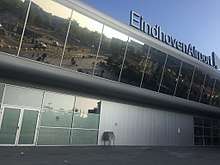
Eindhoven Airport is the closest airport, located approximately 8 kilometres (5 miles) from the town centre. The airport serves as a military air base and a civilian commercial airport. Eindhoven Airport is the second-busiest in the Netherlands (after Schiphol).
Ryanair serves London Stansted airport, Dublin, Kiev, Rome, Milan, Pisa, Bordeaux, Marseille, Glasgow, Madrid, Valencia, Stockholm, Kaunas, Malta, Sofia and Barcelona. Wizz air serves Belgrade, Brno, Bucharest-Baneasa, Budapest, Cluj-Napoca, Debrecen, Gdańsk, Katowice, Prague, Riga, Sofia, Timișoara, Vilnius, Wrocław. In the summer season, Reykjavík is served with 2 weekly flights operated by Iceland Express. Transavia services Alicante, Antalya, Bodrum, Corfu, Dalaman, Faro, Gran Canaria, Innsbruck, Málaga, Majorca, Munich, Prague, Rhodes and Salzburg, though some destinations are served only seasonally. Eindhoven Airport served more than 6.2 million passengers in 2018.
Eindhoven is a rail transport hub. Eindhoven Centraal railway station is the main station in Eindhoven. It has connections in the directions of:
- Tilburg – Breda – Rotterdam – Delft – The Hague[58]
- 's-Hertogenbosch – Utrecht – Amsterdam – Alkmaar/Enkhuizen[59]
- 's-Hertogenbosch – Utrecht – Amsterdam Zuid – Schiphol Airport[59]
- Helmond – Venlo-(international connections into Germany)[58]
- Weert – Roermond – Sittard – Maastricht/Heerlen[60]
Eindhoven Centraal is served by both intercity and local services while the smaller station, Eindhoven Strijp-S is only served by local trains. Towards 's-Hertogenbosch, Utrecht and Amsterdam trains run every ten minutes, on every day of the week. Eindhoven Stadion is a small station that serves Philips Stadion in the event of football matches or other special events at the stadium. It is located 900m west of the main station.
Up until World War II, a train service connected Amsterdam to Liège via Eindhoven and Valkenswaard, but the service was discontinued and the line broken up. Recently, talks have resumed to have a service to Neerpelt, Belgium via Weert.
The A2/E25 motorway from Amsterdam to Luxembourg passes Eindhoven to the west and south of the city. The A2 connects to the highway A58 to Tilburg and Breda just north of the city. Just south of Eindhoven, the A2 connects to the A67 / E34 between Antwerp and Duisburg. In 2006, the A50 was completed connecting Eindhoven to Nijmegen and Zwolle.
The public transport of Eindhoven consists of more than 20 city bus lines, which also serve neighbouring villages such as Veldhoven, Geldrop and Nuenen. Seven of these buslines (400 - 407) are marketed as high quality public transport and run with 43 electric articulated busses. Two specially built separated busways (HOV1 & HOV2) are used by lines 401 to 406. Line 401 to the airport runs almost completely on separated busways. Apart from the city lines there are some 30 regional and rush-hour lines.
Like all large Dutch cities, Eindhoven has an extensive network of bicycle paths. Since 2012, the Eindhoven bicycle path network has incorporated the Hovenring.
Medical care
Eindhoven has two hospitals in three locations: the Catharina Hospital and the Máxima Medisch Centrum, which has a branch in Woensel-Zuid (the old Diaconessenhuis) and one in Veldhoven (the old Sint Joseph Hospital). These three have an extensive cooperation and have divided specialties among each other. Emergency medicine, for example, is concentrated in the MMC Veldhoven branch and the Catharina Hospital, the MMC Eindhoven branch has no emergency department. Cardiac procedures are done in the Catharina.
Catharina is also an academic and research hospital and participates in a shared research program with Philips Medical, the Eindhoven University of Technology and the Maastricht University into biomedical science, technology and engineering.
Notable residents
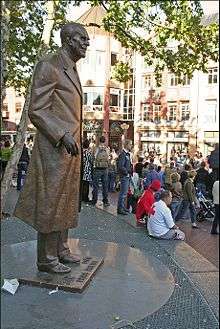
- Kees Bol (1916–2009), painter and art educator
- Jan de Bont (born 1943), film director
- Hugo Brandt Corstius (born 1935–2014), writer
- Rene Daniels (born 1950), painter
- Patrick van Deurzen (born 1964), composer
- Cor Dillen (1920–2009), businessman and Director of Philips in South America
- Sander van Doorn (born 1979), Techno/Trance music DJ and producer
- Lonneke Engel (born 1981), fashion model
- Jalila Essaïdi (born 1980), artist and entrepreneur
- Jan van Hooff (1755–1816), statesman
- Nicole van den Hurk (1980–95), homicide victim
- Peter Koelewijn (born 1940), musician and record producer
- Lenny Kuhr (born 1950), singer-songwriter
- Ton de Leeuw, (born 1941), organizational theorist
- Theo Maassen (born 1966), comedian and actor
- Tom van den Nieuwenhuijzen (born 1982), politician
- Frits Philips (1905–2005), businessman, son of Anton Philips
- Gerard Philips (1858–1942) and Anton Philips (1874–1951), founders of the Philips brand name
- Bas Rutten (born 1965), MMA sportsman, color commentator, actor
- Piet Souer (born 1945), record producer
- Brooks (born 1995), DJ & record producer
Sport
- Peter Aerts (born 1970), kickboxer
- Christijan Albers (born 1979), Formula One racing driver
- Imke Bartels (born 1977), equestrian
- Tineke Bartels (born 1951), equestrian
- Arthur Borren (born 1949), field hockey player
- Jan Borren (born 1947), field hockey player and coach
- Phillip Cocu (born 1970), football player
- Paul Haarhuis (born 1966), tennis player
- François van Kruijsdijk (born 1952), medley swimmer
- Patrick Lodewijks (born 1967), football goalkeeper
- Rob Reckers (born 1981), (field) hockey player
- Rik Smits (born 1966), basketball player
- Margje Teeuwen (born 1974), field hockey midfielder
- Rick VandenHurk (born 1985), baseball player
- Tisha Volleman (born 1999), artistic gymnast
- Cor Vriend (born 1949), long-distance runner, currently manager for long-distance runner
- Remmert Wielinga (born 1978), professional road bicycle racer
- Robert de Wit (born 1962), decathlete and bobsledder
- Klaas-Erik Zwering (born 1981), swimmer
Twin towns – sister cities
Eindhoven is twinned with:
See also
- List of cities in the Netherlands by province#North Brabant
- Jewish Eindhoven
- BrabantStad
References
- "John Jorritsma" (in Dutch). Gemeente Eindhoven. Archived from the original on 13 January 2017. Retrieved 11 January 2017.
- "Kerncijfers wijken en buurten" [Key figures for neighbourhoods]. CBS Statline (in Dutch). CBS. 2 July 2013. Retrieved 12 March 2014.
- "Postcodetool for 5611EM". Actueel Hoogtebestand Nederland (in Dutch). Het Waterschapshuis. Retrieved 15 April 2014.
- "Bevolkingsontwikkeling; regio per maand" [Population growth; regions per month]. CBS Statline (in Dutch). CBS. 1 January 2019. Retrieved 1 January 2019.
- "Bevolkingsontwikkeling; regio per maand" [Population growth; regions per month]. CBS Statline (in Dutch). CBS. 26 June 2014. Retrieved 24 July 2014.
- "Bevolkingsontwikkeling; regio per maand" [Population growth; regions per month]. CBS Statline; Metro region (in Dutch). CBS. 31 August 2015. Retrieved 13 October 2015.
- "Bevolkingsontwikkeling; regio per maand" [Population growth; regions per month]. CBS Statline; CMSA (in Dutch). CBS. 31 August 2015. Retrieved 13 October 2015.
- Schippers, Hans (2009), "Stadsrechten en een stadswapen, 1232: het vroege Eindhoven", in Lintsen, Harry; et al. (eds.), De canon van Eindhoven (in Dutch), 's-Hertogenbosch: Heijnen, pp. 29–34, ISBN 9789086801275
- The Gender was dammed short of the city centre in the 1950s, but the Dommel still runs through the city.
- Bevolking 2015
- "Eindhoven - Groei van Eindhoven (inwoners)". Eindhoven.nl. 30 April 2016. Archived from the original on 6 March 2017. Retrieved 5 March 2017.
- "Archived copy". Archived from the original on 6 July 2007. Retrieved 6 July 2007.CS1 maint: archived copy as title (link)
- "Low level daylight attack on the Philips plant, Holland - WWII Today". 6 December 2012.
- "Map and De Nieuwe Gender" (in Dutch). Archived from the original on 28 August 2007. Retrieved 5 March 2017.
- worldpopulationreview.com http://worldpopulationreview.com/world-cities/eindhoven-population/. Retrieved 19 November 2019. Missing or empty
|title=(help) - Eindhoven Population Central Bureau of Statistics. Accessed 29 August 2010 (in Dutch)
- Jos & Cor Swanenberg: Taal in stad en land: Oost-Brabants, ISBN 9012090105
- http://eindhoven.buurtmonitor.nl/ eindhoven.buurtmonitor.nl
- http://www.rtlnieuws.nl/buurtfacts/opmerkelijk!/Geloof/noord-brabant/eindhoven///religie-Eindhoven%5B%5D
- "Archived copy". Archived from the original on 22 October 2010. Retrieved 30 August 2010.CS1 maint: archived copy as title (link)
- "Archived copy". Archived from the original on 13 June 2011. Retrieved 11 June 2011.CS1 maint: archived copy as title (link)
- "Gereg.criminaliteit; misdrijven naar soort misdrijf en politieregio" (in Dutch). CBS Statline. 7 July 2010. Retrieved 2 September 2010.
- "Dè is toch wè?! Wim Daniëls maakt Brabants theaterstuk 'Een ons komma's' | Hallo 040". Archived from the original on 4 March 2016. Retrieved 7 June 2015.
- Wenstedt, Joop (25 September 2010). "Nieuw testlab voor hoogwaardige verpakkingen" [New testing lab for high-grade packaging materials]. Technisch Weekblad (in Dutch). The Hague, Netherlands: Uitgeverij Bèta Publishers. Archived from the original on 19 July 2011. Retrieved 30 September 2010.
- "Centrum kunstlicht in de kunst te Eindhoven. Museum voor lichtkunst en lichteffecten" (in Dutch). Kunstlichtkunst.nl. Retrieved 5 May 2009.
- "Philips gloeilampenfabriekje anno 1891". Philipsfabriek1891.nl. Archived from the original on 24 January 2001. Retrieved 5 May 2009.
- "Brainport". Brainport.nl. 18 February 2017. Retrieved 5 March 2017.
- "Home - Brainport Development". Brainportdevelopment.nl. Retrieved 5 March 2017.
- Morisson, A. & Doussineau, M. (2019). Regional innovation governance and place-based policies: design, implementation and implications. Regional Studies, Regional Science,6(1),101–116. https://rsa.tandfonline.com/doi/full/10.1080/21681376.2019.1578257.
- "Archived copy". Archived from the original on 8 April 2010. Retrieved 29 August 2010.CS1 maint: archived copy as title (link)
- Archived 13 March 2014 at the Wayback Machine
- "Intelligent Community Forum Announces Top Seven Intelligent Communities of 2011". Intelligent Community Forum. 19 January 2011. Archived from the original on 22 July 2011. Retrieved 23 January 2011.
- Postma, Renée. "Brabantse techniek terug in de wereld" [Brabant technology back in the world]. NRC Handelsblad (in Dutch). p. 13. Retrieved 23 January 2011.
- "ICF Names Eindhoven Region of the Netherlands as its Intelligent Community of the Year 2011". Intelligent Community Forum. 3 June 2011. Archived from the original on 26 July 2011. Retrieved 4 June 2011.
- "European Institute of Innovation and Technology: Home". Eit.europa.eu. Archived from the original on 28 March 2010. Retrieved 2011-06-01.
- "Databank verkiezingsuitslagen". Verkiezingsuitslagen.nl. Retrieved 5 March 2017.
- "College van B&W 2014–2018" (in Dutch). Gemeente Eindhoven. Archived from the original on 3 August 2014. Retrieved 20 May 2014.
- 'Lichtproject op Strijp-S pakt Auroralia Award in Lyon', Eindhovens Dagblad.
- 'Herbeleef Glow Eindhoven: Routes en hoogtepunten door de jaren heen', Eindhovens Dagblad.
- 'Licht zien, voelen en zelfs opslaan op Glow Next', Eindhovens Dagblad.
- Evenement. "Effenaar". Effenaar.nl. Retrieved 5 May 2009.
- "Studium Generale Eindhoven". Studiumgenerale-eindhoven.nl. Archived from the original on 22 July 2010. Retrieved 5 March 2017.
- "Tuna Ciudad de Luz". Tuna Ciudad de Luz. Archived from the original on 24 July 2011. Retrieved 29 August 2010.
- "La Tuniña". La Tuniña. Archived from the original on 24 July 2011. Retrieved 29 August 2010.
- "Home | POPEI". Popei.nl. 22 February 2017. Retrieved 5 March 2017.
- "ABlive gratis festival Eindhoven 23 Augustus 2008". Ablive.nl. Retrieved 5 May 2009.
- "Muziek op de Dommel gratis toegankelijk klassiek muziek festival". muziekopdedommel.nl. Archived from the original on 22 March 2017. Retrieved 4 August 2013.
- "Stichting Virus – Startpagina". Virus.nl. Archived from the original on 12 July 2017. Retrieved 5 May 2009.
- "STRP Festival". Strp.nl. Retrieved 5 May 2009. Dominator Festival - Hardcore Music Festival (July). Run by Q-Dance and Art of dance
- "Profiel: Buurten in Nederland". NRC Handelsblad (in Dutch). 18 September 1997. Retrieved 2 September 2010.
- "Hockeyers Oranje Zwart voor de derde keer op rij kampioen". NRC Handelsblad (in Dutch). 8 May 2016. Retrieved 19 November 2016.
- "Oranje Zwart wint EHL-finale na shoot-outs" (in Dutch). NOS. 6 April 2015. Retrieved 19 November 2016.
- "First training session of 2019". 6 March 2019. Retrieved 7 March 2019.
- "Benelux Winners 2017". 2017. Retrieved 7 March 2019.
- "Archived copy". Archived from the original on 6 March 2010. Retrieved 10 September 2010.CS1 maint: archived copy as title (link)
- "Archived copy" (PDF). Archived from the original (PDF) on 2 April 2015. Retrieved 17 January 2014.CS1 maint: archived copy as title (link)
- "Archived copy" (PDF). Archived from the original (PDF) on 2 April 2015. Retrieved 17 January 2014.CS1 maint: archived copy as title (link)
- "Archived copy" (PDF). Archived from the original (PDF) on 2 April 2015. Retrieved 17 January 2014.CS1 maint: archived copy as title (link)
- "Les villes jumelles". bayeux.fr (in French). Bayeux. Retrieved 3 November 2019.
- "Współpraca zagraniczna". bialystok.pl (in Polish). Białystok. Retrieved 3 November 2019.
- "Quienes Somos". chinantlan.org (in Spanish). Chinantlan. Retrieved 15 June 2020.
- "リンク集". city.kadoma.osaka.jp (in Japanese). Kadoma. Retrieved 15 June 2020.
- "Twin towns of Minsk". minsk.gov.by. Minsk. Retrieved 12 January 2020.
- "Eindhoven's sister city Nanjing shines light on Eindhoven". eindhovennews.com. Eindhoven News. 10 September 2019. Retrieved 12 January 2020.
Bibliography
External links
![]()
![]()

